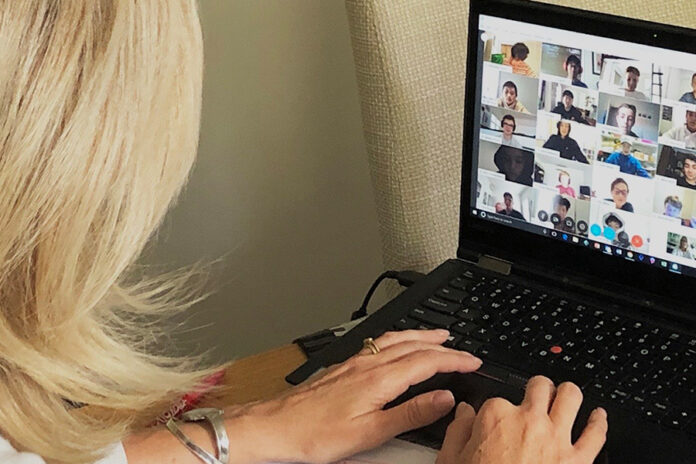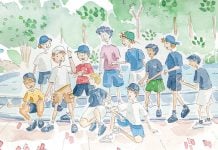Teaching and learning at Melbourne Grammar School has always been adaptive and responsive to the demands of the time. Our swift transition to an off-campus learning model in the wake of COVID-19 has been no exception.
In reframing our educational programmes, we have drawn from our own extensive knowledge of the teaching approaches that best support online learning, as well as from the experiences of educational institutions around the world. Importantly, we have also drawn from – and continue to rely on – the direct experiences of our teaching staff, students and parent community.
Off-campus teaching is currently taking place at an unprecedented scale around the world, but this does not mean the approaches that underpin this model of teaching are untested. We know, for example, that the way we teach online must reflect the differences present in an online space. We cannot simply apply a standard classroom plan to an off-campus school day.
The situation is further complicated when we take the nature of our off-campus student community into account. In addition to teaching students based in Melbourne and country Victoria, we have boarders who have returned home to other countries and Australian states, many of whom are taking part in classes across different time zones.
Achieving consistently positive outcomes for students in an off-campus environment calls for creativity. We must create the right mix of peer interaction, feedback, self-assessment and group work. We must also consider the medium used to deliver teaching instruction for each new task, along with the tools used for assessment. Considering the merits and limits digital tools is essential to building an effective off-campus learning experience.
There are several advantages for the learner working at home. With no commuting needed, more time is available at the start and end of the day. If a blend of modes is used, there can still be a high level of engagement and good learning occurring. Comfort, food and sleep can be more readily accessible at home.
Some disadvantages do exist. Social and physical isolation pose problems and the learning that comes from peer interactions is much harder to replicate. Students and teachers spending significant parts of each day seated in front of a screen report increased fatigue and lower levels of concentration. It is considerably harder to use direct instruction and discussion as teaching pedagogies as the normal body language and physical cues are missing.
Finally, the most obvious issue is the heavy reliance on the internet and home computing resources. Should these fail or be compromised, the teaching and learning quickly comes to a halt.
The two modes of teacher / student interaction are classified as Synchronous (teacher and student working together at the same time) and Asynchronous (teacher and student working at different times). Both are being employed at Melbourne Grammar School, depending upon the situation and learning needs.
Synchronous
Advantages
- Quick feedback and interaction.
- Teachers can monitor the pace and sequence of learning more readily.
- Discussion and question exploration are more natural and mimic the normal classroom environment.
- Students can interact with each other as well as the teacher.
- Students need to be present, and the structure assists those who have low motivation or who otherwise wouldn’t engage.
Disadvantages
- Each participant is fixed in location and tends to be passive, sitting and looking at the screen.
- The normal body language and environmental cues are missing making it harder for teachers and students to pick up nuance.
- It is harder for the teacher to use a range of instructional strategies as the prime channel is through the web interface. For example, Science or Art practical work is almost impossible.
Asynchronous
Advantages
- Students have control over when, and for how long, they work.
- Teachers can pre-prepare material and provide a pathway for students to follow. Students can then see the overall direction and work at their own pace.
- Students can pause, repeat or consolidate material in their own time.
- There can be a wider variety of media and other resources used.
- Student work can be submitted online for teacher consideration and feedback.
Disadvantages
- Motivation and organisation can be a problem for some students.
- Freedom of choice can mean that some subjects get too much time and others not enough to maintain good learning.
- There can be a temptation for teachers to prepare too much work as the normal constraints of a classroom period are missing.
- Teachers need to check emails and other asynchronous communications more regularly so that they can respond to students promptly.
Our approach to specialist subjects also reflects our understanding that off-campus learning presents opportunities as well as challenges. While students may not be able to gather in a science lab or art classroom, they are able to explore the theoretical aspects of the course. Where possible, students will be given some activities they can undertake at home.
One aspect of learning and teaching that has not changed under the off-campus model is our approach to pastoral care. The wellbeing of our students remains central to everything we do as a School. At secondary level House tutors and students will meet virtually and engage in social activities as much as practicable. In the primary class groups, the pastoral care rests with the class teacher and there will be daily contact between teacher and students. A wide range of activities is planned by students and teachers. Our school psychologists and chaplains continue to be available and, as always, any student can still access support and help from any teacher.
Across all these aspects of off-campus teaching and learning, flexibility and reflection are paramount. After all, part of learning is testing to see what works, and reflecting on what does not. Continuing to do this leverages the skills and capabilities of our staff. Our expertise, empathy and understanding of our students means we are well positioned to make the most of our time off-campus, and to return to the classroom having gained from this experience.
Andrew Baylis
Director of Learning & Research



